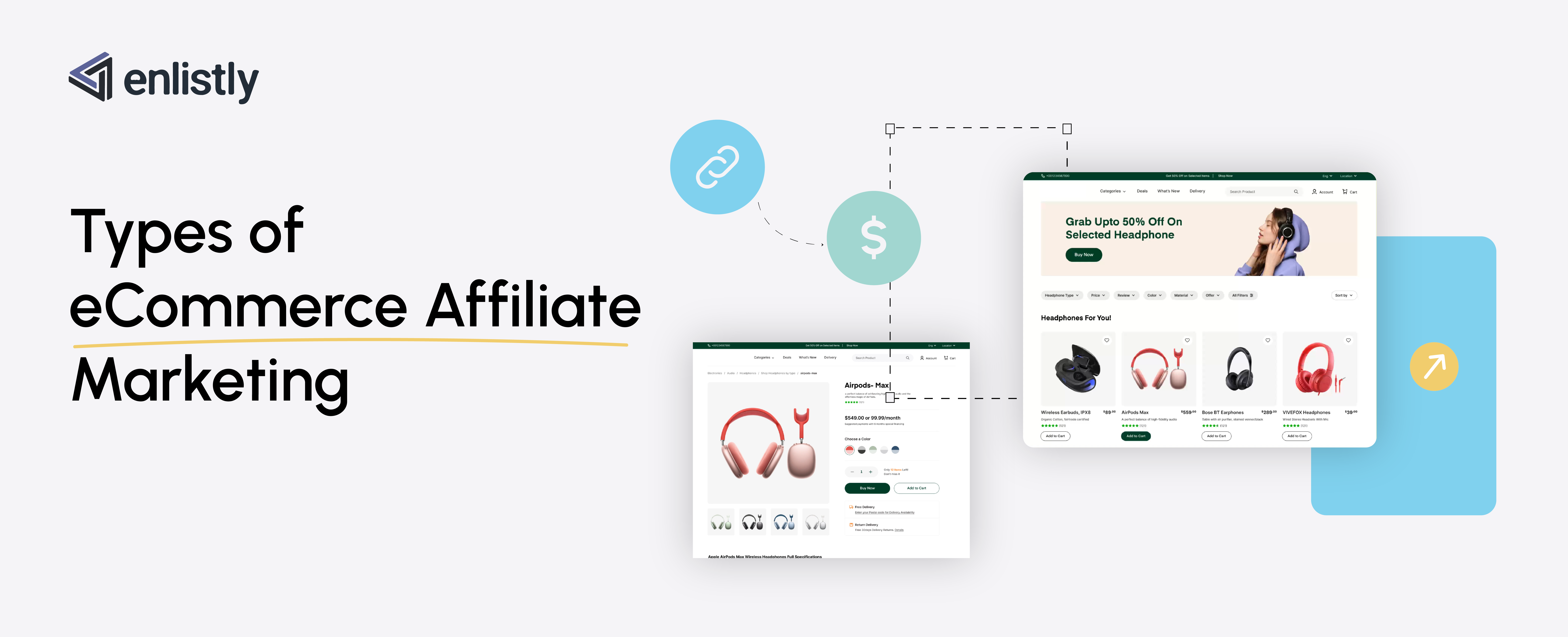How to Set Up Your eCommerce Affiliates For Success

Learn how to help your eCommerce affiliates succeed.
Affiliate marketing is a powerful strategy for eCommerce brands to drive sales and increase brand visibility. This industry has grown faster than expected. It was expected to be valued at around $12 billion in 2022, but in 2019 it crossed $17 billion. That’s a huge jump!
And eCommerce brands have understood its potential.
As a result, 8 out of 10 eCommerce companies are leveraging affiliate marketing to increase their revenue. 16% of all eCommerce sales in Canada and the US are generated via affiliate marketing channels.
Brands are outstandingly increasing their efforts in bringing more affiliate sign-ups.
However, simply having affiliates sign up for your program isn’t enough to ensure success. You must take an active role in setting up your affiliates for success.
Once you’ve successfully signed up a significant number of affiliates, your work is far from finished.
You must ensure that these affiliates are actively engaged in the program and proactively promoting your brand.
As an eCommerce brand, you play a crucial role in equipping your affiliates with the tools they need to be successful. You should provide them with the right resources and support to help them promote your products and drive sales.
This guide will provide you with a list of things to help you equip your affiliates for success.
Let’s not keep you waiting and dive right in!
10 Things You Need to Ensure to Set Up Affiliates for Success
The easier it is for your affiliates to sell your products, the more sales you will get. Think of your affiliate marketing program as a two-way relationship rather than a one-way relationship where you only expect your affiliates to bring sales. Here’s a list of things you can do for them to bring more sales.
1. Make the Sign-up Process Seamless
The first step in setting up your affiliates for success is to make the sign-up process as seamless as possible. As an eCommerce brand, you want to make it easy for your potential affiliates to sign-up without any barriers or delays.
For starters, you can consider allowing affiliates to sign up using their email or social accounts. According to a report by CXL, 77% of internet users want websites to have the social login option because they don’t want to create new accounts from scratch.
And for affiliates who don’t sign-up with social accounts, it’s crucial for you to streamline the number of fields in your sign-up form.
While it’s tempting to ask for a lot of information during the sign-up process, this can be a turn-off for potential affiliates. Streamline the sign-up process to include only the essential information, such as the affiliate’s name, email address, and payment information.
Take Newchic’s affiliate marketing program, for example. Their sign-up form is as simple as it can get. They offer social and email login. And there are only two fields that users need to fill in if they don’t want to continue with social login, i.e., email address and password.
By making the sign-up process simple and quick, you’re more likely to attract new affiliates and encourage them to promote your products immediately.
2. Explain the Rewards and Benefits
On the landing page of your eCommerce store’s affiliate marketing program, you must have mentioned the rewards your affiliate can avail. But sometimes that’s not enough.
As soon as the affiliates complete the sign-up process, they should be redirected to a dedicated rewards and benefits page. You can set the tone for the affiliate’s journey by reinforcing the benefits at this stage. Explain how the program works and how they can earn commissions for their efforts.
You must also ensure that all the concerns or questions of your affiliates are addressed as soon as they have them. By providing clear communication and transparency, you can build trust with your affiliates and motivate them to promote your brand.
It’s essential to maintain an ongoing dialogue with your affiliates and let them know that their success is your success.
By doing this, you can build a loyal and enthusiastic group of affiliates who will actively promote your brand and drive more traffic and sales to your eCommerce store.
3. Customise Promotional URLs
Once the sign-up process is set and affiliates clearly understand the commission structure, it’s time for some customization.
By providing your affiliates with customised links, you are enabling them to promote your brand in a more effective and personalised way.
Instead of using third-party link generators or customizers, they can use the custom links you provide within the dashboard. Ideally, each affiliate should have a unique link tailored to their audience and promotional methods.
For example, Let’s say Jane is a social media influencer who recommends products to her audience. You can customise her affiliate URL as something like www.storename.com/jane-recommends.
This not only makes it easier for affiliates to share your products with their followers, but it also helps to build their personal brand. By using customised URLs with their name or brand included, affiliates can establish themselves as an authority in your niche and build trust with their audience.
Using customised URLs also allows you to track the performance of each individual affiliate, making it easier to measure the effectiveness of your affiliate program.
4. Provide Unique Promotional Codes
Providing unique promotional codes to your affiliates is another way to make it easy for them to promote your brand and track their success.
These codes can be included in their content, such as social media posts, blog articles, or videos, and will allow them to offer exclusive discounts or special offers to their followers.
Using unique promotional codes also enables you to track the performance of each affiliate more efficiently, as you can see how many conversions were generated by each code. This information can help you to identify your top-performing affiliates and optimise your program for maximum success.
Moreover, offering unique promotional codes adds a layer of legitimacy to your affiliate program. When your affiliates share their codes with their audience, it demonstrates that they have a genuine relationship with your brand and are not just spamming their followers with generic promotions. This can build trust with their audience and encourage more conversions.
5. Provide Media Assets to Affiliates
Continuing on the theme of providing affiliates with the tools they need to succeed, the next crucial thing you can do is equip them with various marketing collaterals. This includes everything from banner images, social media images, logos, taglines, and captions, to any other creative materials they can use to promote your brand.
By providing these assets, you not only make it easier for affiliates to promote your products or services, but you also ensure consistency in messaging and branding across different platforms. Providing these media assets will also ensure you don’t ever have to worry about your product not meeting the customers’ expectations because of some affiliates sharing a different image.
And consistent brand messaging helps build a strong brand identity and increase trust among potential customers. Simple logic — the more they trust, the more likely they are to buy.
Moreover, by providing your affiliates with a wide variety of marketing materials, you give them the flexibility to choose the ones that best align with their own personal brand and the needs of their audience.
6. Make Products Easy to Share
Affiliates don’t want to spend too much time sharing the product with their customers. Their income relies on the number of sales made. So, if they want to earn more, they need to share as many products as they can in less time.
So making products easy to share not only helps affiliates but also improves the chances of generating more sales for your eCommerce brand.
Amazon’s affiliate program is an excellent example of how easy sharing can increase participation. With just one click, affiliates can share a product on their social media, blog, or website.
On Amazon’s Affiliate Products page, affiliates can click the link by simply clicking on SiteStripe and selecting the type of link they want. It can be just text, image, or both text and image.
You see how there are social share buttons on Amazon’s SiteStripe? You should enable the same for your affiliates because one-click sharing makes the whole process quite seamless for affiliates.
Also, allow them to customise product images, like adding their unique promotional code or name. It will help increase their chances of promoting the products on their preferred platforms.
You can also provide them with pre-written social media posts, which they can use to promote products quickly. The quicker it is for them to promote your products, the more of your products they’ll share.
7. Create Educational Content
Now that your eCommerce brand is officially on a giving spree — let’s give some more. What’s left to give? There’s a lot, but let’s talk about providing affiliates with educational content.
Creating educational content like how-to guides or blog posts that explain how to promote your brand effectively can be incredibly helpful for your affiliates, especially if they’re new to affiliate marketing.
These educational resources should cover topics such as best practices for promoting your products, how to use promotional materials, how to leverage social media, and other tips and tricks to increase their commissions.
By providing this type of content, you’re empowering your affiliates with the knowledge they need to be successful and reinforcing your commitment to their success.
When affiliates feel supported and empowered, they’re more likely to promote your brand enthusiastically and deliver results.
8. Keep Your Affiliates Engaged
Affiliates often sign up for programs and then just forget about it. And if you want their success (which is yours, too), then this is not the path you want them to go on. It’s not enough to just get a sign-up. You also need to keep them motivated to promote your brand.
Many affiliates sign up for multiple programs and may forget to be active with yours. To ensure your program stays top-of-mind, it’s essential to keep your affiliates engaged.
This can be done through automated emails, SMS, and other communication channels. The more you get in touch with them, the more they’ll think about your affiliate program.
Regularly send out newsletters, promotions, and updates about new products or services. This will not only help keep your affiliates engaged, but it can also help to build a community of advocates who feel invested in your brand’s success.
9. Make Success Tracking Easy For Affiliates
Affiliate marketing is a performance-based marketing strategy. Thus, it is crucial to track the success of affiliates to reward them for their efforts and motivate them to promote your brand more.
And from an eCommerce brand’s perspective, it’s equally essential for affiliates to track their success because numbers are the biggest motivators in sales. If they get good results, they’ll push harder to get even better.
To make success tracking easy for affiliates, give them access to an analytics dashboard that lets them see how many products they have promoted, the reach, and the number of clicks they generated. It should also include the number of orders your brand got through them and how much they earned from those orders.
Providing a transparent and easily accessible analytics dashboard not only keeps the affiliates motivated but also helps eCommerce brands to track the success of their affiliate program.
By having a detailed understanding of the performance of each affiliate, brands can identify top-performing affiliates, the products that are most popular among their audiences, and the promotions that drive the most sales.
This transparent and seamless tracking can help build trust between eCommerce brands and their affiliates, leading to longer-lasting partnerships and greater brand loyalty.
10. Create a Community of Affiliates
Creating a community of affiliates not only helps the affiliates connect and collaborate with each other but also creates a sense of belonging and loyalty to your brand.
Because whenever someone engages in the community, other affiliates will also get reminded of your brand. And by seeing others work passionately with you, they’ll be motivated to sell more.
Affiliates who feel connected to your brand and its mission are more likely to promote your products passionately and authentically. They can also provide valuable feedback and suggestions to improve your affiliate program and product offerings.
Moreover, having a solid community of affiliates can also lead to positive word-of-mouth marketing and brand advocacy, which can help drive more traffic and sales to your eCommerce store.
Final Thoughts
Setting up your affiliates for success requires attention to detail and a commitment to providing them with the resources they need to be successful.
It’s essential to keep affiliates engaged and motivated by tracking their success and providing them with feedback. And not just providing feedback but always being open to feedback from them in return too.
By working on their feedback and focusing on their needs, you can build a strong word-of-mouth marketing campaign that will benefit both your business and your brand advocates.
Found this blog helpful? For more tips and insights on affiliate marketing and management, subscribe to the Enlistly blog.




